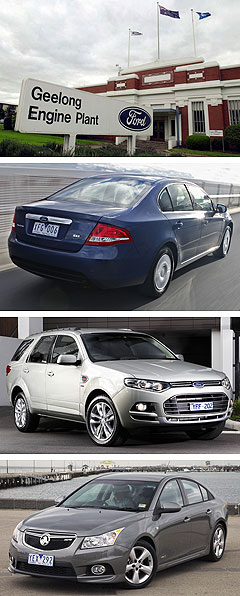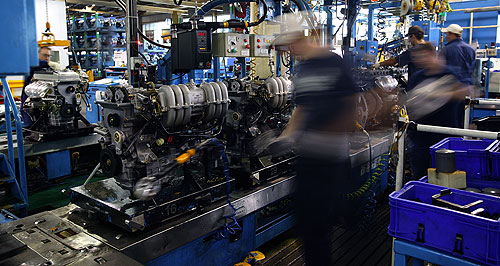Make / Model Search
News - FordFord buys time on engine deadlineFalcon powertrain: The phasing in of Euro 5 emissions regulations will give Ford time to decide the future of its Australian-made six-cylinder engine. Phased Euro 5 emissions introduction points to 2016 crunch date for Ford I614 Jun 2011 FORD Australia will use breathing space provided by the phasing in of new Euro 5 anti-pollution regulations by the federal government to decide the fate of its locally made six-cylinder engine for Falcon and Territory. The company has confirmed to GoAuto that the inline 4.0-litre engine made at Geelong, Victoria, can be upgraded to meet the new emissions standard that becomes compulsory on all new cars in November 2016, but only by investing significant time and resources. The investment would stretch the life of the engine – and the Geelong engine plant and its 400-plus workers – until at least mid-2018, when it would face another hurdle with the introduction of the even tougher Euro 6 emissions rules. The alternative is to make the switch to Ford Motor Co’s new 3.5-litre EcoBoost V6 that would almost certainly be imported, alongside the 2.0-litre EcoBoost four-cylinder engine destined for a facelifted Falcon in the first quarter of next year. Ultimately, the imported V6 might be the only path open to Ford if, as widely predicted, it scraps its rear-drive home-grown Falcon platform in favour of a Taurus-based replacement in front- and all-wheel-drive configurations. GoAuto has learnt that the Falcon/Territory platform reaches the end of the line in 2016. This would therefore be a likely time for the Falcon’s successor to switch to the new V6 engine, which is already in service overseas.  From top: Ford's Geelong engine plant, Ford Falcon, Ford Territory, Holden Cruze. From top: Ford's Geelong engine plant, Ford Falcon, Ford Territory, Holden Cruze.Federal industry minister Kim Carr told GoAuto recently that the future of the Geelong plant was secure “through to at least 2016”. In the timeline for the new Euro 5/6 regulations announced at the weekend by transport minister Anthony Albanese, November 1, 2016, was a key date, marking the end of the road for Euro 4 light vehicles and the introduction of mandatory Euro 5 emissions standards on all cars, SUVs and light trucks, regardless of when they were launched. Ford Australia public affairs director Sinead McAlary said the timing of the Euro 5 date was coincidental as far as Ford was concerned. “It is possible to engineer our I6 engine to meet the new emissions requirements,” she said. “However, significant time and resources would be required to do so. So, one of the advantages of the regulatory timing we have received is that we actually have the time now to work through all the options to determine if that is the right course of action to take.” Ms McAlary said the forthcoming LPG-fuelled EcoLPI version of the I6 engine would be compliant only with current Euro 4 regulations, and would also require work to achieve the higher grading. “And that’s one of the things we have to work on,” she said. “Again, the I6 engine is obviously the basis of the LPI system as well. So, whatever we decide to do with the I6 will affect the LPI as well.” Asked if Ford Australia would consider making the new EcoBoost V6 at Geelong, Ms McAlary said: “That is not on the horizon at this stage, no.” The federal government originally proposed to introduce Euro 5 emissions standards for hydrocarbons, oxides of nitrogen and particulates from 2012, with Euro 6 starting in 2016. Now, the Euro 5 standards will be phased in, starting on November 2013 with what the government calls “core Euro 5” – a modified version of the European standard to accommodate vehicles made in Australia. Euro 4 cars launched before that date can still be sold, at least until November 1, 2016, when “full Euro 5” kicks in for all light vehicles, regardless of when they were introduced. Less than a year later, on July 1, 2017, the Euro 6 standard is mandatory for all new models introduced from that date, and then becomes compulsory on all new cars sold after July 1, 2018. The timeframe has been welcomed by the industry, although with some reservations about its effectiveness (see separate story). GM Holden and Toyota both say their locally produced models will meet the regulations, with planning afoot to upgrade Holden’s Melbourne-made Global V6 and Toyota’s all-new 2.5-litre four-cylinder Camry engine to be produced at its newly refurbished Altona factory from early next year. Holden already makes and exports a Euro 5-compliant 2.8-litre turbo V6 version of the engine for Opel/Vauxhall’s Insignia VRX in Europe. GM Holden director of external communications Emily Perry said Holden had already started introducing Euro 5 vehicles “ahead of the regulations”. She said the new locally built Cruze was already Euro 5 compliant, and others would follow as Holden made it mandatory on all its vehicles, local or imported. “So from Holden’s point of view, the Euro 5 emissions standards timeframe is appropriate for the industry to be able to adapt to those requirements,” she said. Ms Perry declined to say if the revised LPG Commodore that the company is set to introduce later this year would make the Euro 5 grade, saying only that all Holden models would comply with the newly announced timeframe. Likewise, she would not comment on how Holden would achieve Euro 5 standards with its V8 models, which currently run a Euro 4-compliant American-made 6.0-litre Gen 4 V8. GM reportedly has an advanced Gen 5 V8 in the pipeline, last year announcing funding of almost $900 million to tool up for the new engine that will employ direct injection and be E85 capable. Such an engine might be slotted into the VF Commodore due in about 2014, comfortably making the deadline. Ford axed its 5.4-litre V8 from the standard Falcon range last year because it could not meet Euro 4, instead slotting its new Australianised supercharged ‘Miami’ 5.0-litre version of the Blue Oval’s Coyote V8 into the Ford Performance Vehicles range. When Euro 5 arrives, Ford will need to find emissions improvement for its newly released 2.7-litre Duratorq TDCi in the Territory SUV, as that is Euro 4. The engine – which was used in Land Rover, Jaguar, Peugeot and Citroen ranges – has been discontinued in Europe under Euro 5 rules, replaced by a new 3.0-litre engine. In the federal government’s regulatory impact statement (RIS) on Euro 5/6 last year, an unnamed local manufacturer was said to have asked for three-and-a-half years to deliver “a Euro 5-compliant diesel version of their current petrol model to the Australian market”. “This was for a vehicle which would be built in Australia with an imported diesel engine,” it said.  Read more |
Click to shareFord articlesResearch Ford Motor industry news |












Facebook Twitter Instagram